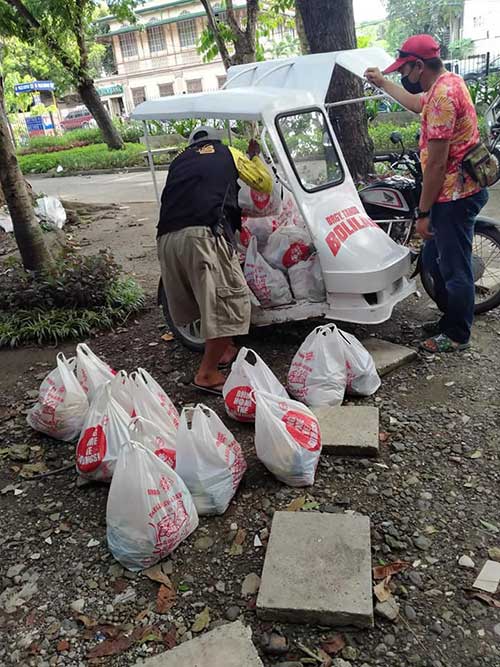Iloilo City – The Department of Health-Western Visayas Center for Health Development (DOH-WV CHD) on Monday said four COVID-19 variants were detected in Region 6.
Based on information from Dr. Bea Camille Fillaro-Natalaray, Medical Officer V of the DOH-WV CHD, the COVID-19 variants included 3 cases of B.1.1.7 (Alpha variant) and case of B.1.351 (Beta variant).
The Alpha variant was first detected in the UK while the Beta variant was traced to South Africa.
Earlier, the World Health Organization announced that coronavirus variants are to be named after letters of the Greek alphabet instead of their place of first discovery in a move to avoid stigma.
COVID variant B.1.617.2, which was first detected in India, is now called Delta strain.
Natalaray said the COVID strains were detected in Overseas Filipino Workers (OFW) and Locally-Stranded Individuals (LSI) from Manila.
The Regional Epidemiological Surveillance Unit (RESU) of DOH-WV CHD sent 251 specimens to the Philippine Genome Center in Diliman, Quezon City, including from areas where clustering of cases had been high, to determine the presence of COVID-19 variants.
Natalaray said the small number of confirmed COVID-19 variants indicates that there is no local transmission of the new strains.
“We are still waiting if there are additional specimens sent, but we only have 4 positive for [foreign COVID-19 variants], 3 for the UK and 1 for the South African variants, but they are OFW and LSI cases. So far, we haven’t had any local case with detected variants,” Natalaray said.
RISK LEVEL
Western Visayas’ COVID-19 risk indicators remain critical, according to the DOH-WV CHD.
DOH data as of June 5 indicated that the region has a cumulative case tally of 50,106
Recent increases in indicators provided a picture of the region’s COVID-19 risk level:
2-Week Growth Rate or 2WGR (from 8.69 percent to 18 percent);
Average Daily Attack Rate or ADAR (4.46 to 5.24); and
Health Care Utilization Rate or HCUR (from 56.65 to 63.37 on May 30).
The region’s COVID-19 positivity rate also continued to rise, at 7.3 percent as of June 5, from 6.9 percent as of May 30.
Western Visayas’ average daily increase in COVID-19 cases from June 1 to 5 is 613 new cases per day, the highest so far compared to May 2021’s overall total of 371 cases daily.
2WGR refers to the rate in percentage of growth in COVID-19 cases in an area over a 14-day period.
The ADAR refers to the number of cases in an area over a 14-day period per 100,000 population compared to the total population.
HCUR refers to the utilization of beds and mechanical ventilators for COVID-19 patients.
Comparing the HCUR between June 5 and May 30, the region climbed from “Low” to “Moderate” classification.
Breaking down the region’s HCUR, DOH-WV CHD data as of June 5 indicated utilization rates of 73 percent of the 156 Intensive Care Unit (ICU) beds, 62 percent of 1,173 isolation beds, 67 percent of 427 COVID ward beds, and 61 percent of 146 mechanical ventilators.
Based on the risk indicators per area, the cities of Bacolod and Iloilo remained at “High”, Aklan (previously at “Low”), Antique, Capiz, Guimaras, and Iloilo province still at “Moderate”, while Negros Occidental remains at “Low” risk.
The changes in risk levels is due to the movement in risk indicators.
Bacolod City experienced a rise in its ADAR (13.43 from 11.61) and HCUR (68.79 percent from 50.28 percent), while its 2WGR declined slightly (16 percent from 17.20 percent).
Iloilo City also saw increases in its ADAR (16.72 from 12.37) and HCUR (82.13 percent from 81.68 percent), but its 2WGR decreased (35 percent from 139.60 percent).
Aklan’s rise to “Moderate” status was due to increases in its ADAR (4.45 from 4.31) and HCUR (36.22 percent from 32.81 percent), while its 2WGR decreased (3 percent from 38.20 percent).
Capiz has shown consistent increases in its ADAR (4.62 from 4.24) and HCUR (80.14 percent from 73.68 percent), despite consistent decrease in 2WGR (9 percent from 37.32 percent).
Like some of its neighbors, Iloilo province’s ADAR (4.17 from 2.86) and HCUR (53.42 percent from 50.79 percent) also increased, while its 2WGR decreased (46 percent from 191.55 percent).
In Guimaras, only the ADAR increased (4.01 from 2.94), while its 2WGR (36 percent from 381.25 percent) and HCUR (64 percent from 90.91 percent) decreased.
Antique saw decreases in its 2WGR (6 percent from 6.70 percent) and HCUR (57.23 percent from 61.48 percent), but its ADAR increased (2.73 from 2.58), keeping it in the “Moderate” classification.
Negros Occidental’s “Low” risk level was due to the decrease in its ADAR (3.21 from 3.33), although its 2WGR (-4 percent from -46.95 percent) and HCUR (49.83 percent from 43.14 percent) climbed.
(Joseph Marzan via The Daily Guardian (TDG), photo courtesy of TDG)

